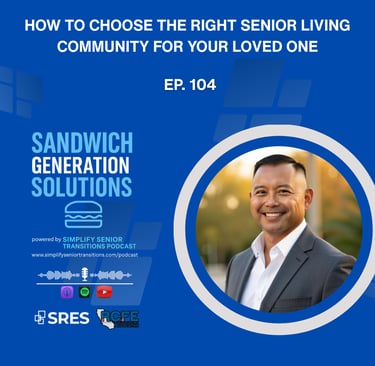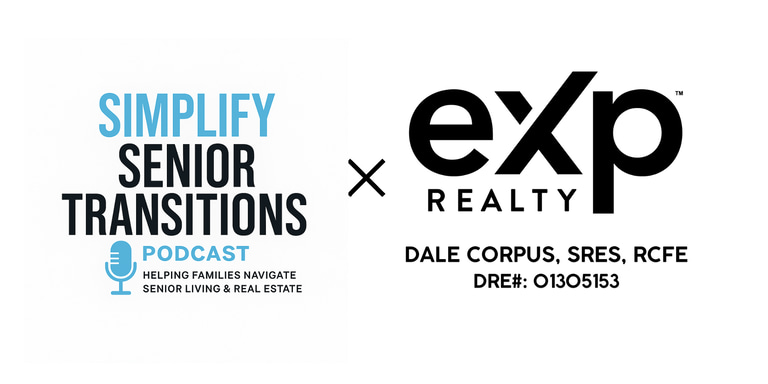Navigating the Senior Transition: How to Choose the Right Community for Your Aging Loved One
A Step-by-Step Guide from Bay Area Senior Transition Expert Dale Corpus
Dale Corpus
10/30/20253 min read
Navigating the Senior Transition: How to Choose the Right Community for Your Aging Loved One
If you are an adult child helping an aging parent in the Bay Area—whether you are facing this challenge in Contra Costa, Alameda, Santa Clara, San Mateo, San Francisco, Solano, or Napa County—you know how overwhelming the decision to move a loved one into senior living can be. It involves complex questions about care, finances, location, and managing immense emotional stress for the whole family.
In Episode 8 of the podcast, "How to Choose the Right Senior Living Community for Your Loved One," senior transition specialist and real estate expert Dale Corpus provides a clear roadmap to navigate this critical life transition. Dale specializes in helping families manage senior home sales and transitions in these specific Bay Area counties.
Here’s What You’ll Learn in This Episode
This episode provides a step-by-step approach to choosing the optimal senior living environment, focusing on understanding immediate needs, thorough research, and planning for the long term.
You will learn the distinctions between various care options (assisted living, memory care, independent living) and gain practical strategies for financing the transition—including how selling the family home can play a role.
Plus, you'll discover key questions to ask during tours to avoid hidden costs and minimize future stress.
Step 1: Understanding Needs and Navigating Finances
The journey begins by truly understanding what your loved one needs, both medically and socially.
Pinpoint the Right Care Level:
It is vital to assess medical needs. If your parent needs assistance with daily activities like bathing, dressing, or medication management, assisted living might be the best fit. If they are dealing with Alzheimer’s or dementia, memory care is likely necessary. However, some seniors may only require independent living coupled with in-home care, which, as Dale notes from a recent client example, can sometimes be a much better fit than automatically opting for assisted living.
Consider Lifestyle Preferences:
Beyond medical requirements, consider what makes your parent happy. Do they thrive in a social and active environment with scheduled activities, or do they prefer a quieter setting with more independence? Finding the right cultural match is crucial for their well-being.
The Financial Path (Including Selling the Home):
Concerns about budget and payment options are almost universal for families. The sources of funding for senior care are varied and may include long-term care insurance, VA benefits, or selling the senior's home. Dale, who works with families to find the best financial path, emphasizes that utilizing real estate expertise can help fund the necessary care.
Step 2: Researching Communities and Avoiding Hidden Costs
Once you have a clear idea of the required care level and budget, it’s time for research.
Tour Strategically:
Don’t settle for the first option you see—schedule multiple tours and compare several communities. During your visits, observe how the staff interacts with residents. Are the employees warm, engaged, and attentive? This interaction provides key insight into the community’s overall quality of care.
The Pro Tip:
Dale recommends asking current residents about their experiences, which offers the most honest insight into what daily life is truly like within the facility.
Beware of Hidden Fees:
A critical practical tip is to inquire about hidden costs. Some facilities charge extra fees for essential services like personal care, specific meal plans, or medical needs. Getting these details upfront can prevent costly surprises later on.
Step 3: Planning for Location and Future Needs
When tackling a significant transition like this, future planning helps reduce potential stress down the line.
Proximity to Family:
If your loved one relies on regular visits, choosing a location close to family can significantly improve their quality of life and make regular visits easier.
Thinking Long-Term (Avoiding Stressful Moves):
One of the biggest stressors families face is needing to move a loved one twice because their health needs changed. To avoid this, consider continuing care communities that can adjust the level of care as health declines.
Dale worked with a family whose mother had to relocate from independent living to assisted living when her needs changed, resulting in extra costs and unnecessary stress—a situation that might have been avoided by choosing a more flexible community initially.
Takeaway: Simplify the Process with the Right Guidance
Choosing the right senior living community is one of the biggest decisions a family will ever make. While it’s a big decision, utilizing a structured approach means it doesn’t have to be stressful.
If you are navigating the complex process of a senior home sale or transition in the Bay Area, we encourage you to take the next step.
Schedule a FREE consultation with Dale and his team to learn more about simplifying your senior transition and home sale process at www.simplifyseniortransitions.com.
Want more detailed advice?
You can listen to the full episode on your preferred podcast platform or contact Dale directly on Instagram @soldbydale.
P.S. Got news or an amazing story to share? Hit us up at dale.corpus@exprealty.com and you might be featured in our next episode!
Remember, always check out the transcript for detailed insights. Happy listening!
Watch The Podcast Here



Transitions Made Simple
Helping seniors transition with ease and peace.
📍 Serving the San Francisco Bay Area
📞 Get in Touch
📬 STAY INFORMED
Dale Corpus, SRES, RCFE
📱 925-380-1657
🕓 Available for free 15 min consultations by appointment
© 2025. All rights reserved.
Sign up for monthly senior transition tips & real estate insights.
